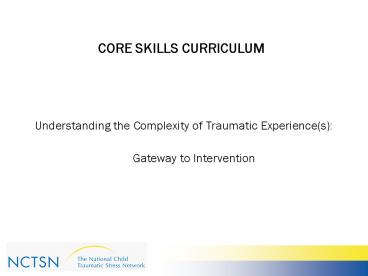CORE SKILLS CURRICULUM - PowerPoint PPT Presentation
1 / 21
Title:
CORE SKILLS CURRICULUM
Description:
Enhance understanding of the complex components of child and adolescent traumatic experiences. ... There is a developmental ontogenesis of danger and response. ... – PowerPoint PPT presentation
Number of Views:207
Avg rating:3.0/5.0
Title: CORE SKILLS CURRICULUM
1
CORE SKILLS CURRICULUM
- Understanding the Complexity of Traumatic
Experience(s) - Gateway to Intervention
2
The Complexity of Traumatic Experience(s) The
Gateway to Intervention
- Objectives
- Enhance understanding of the complex components
of child and adolescent traumatic experiences. - Increase capacity to listen, using a systematic
framework - Increase recognition of omissions and difficult
moments - Enhance clinical confidence to engage children in
trauma narrative work - Appreciate the capacity and courage of children
in meeting the challenge of trauma narrative work
3
Danger Apparatus
- Traumatic experiences need to understood within a
broader context of danger. - The human brain and body are geared to recognize
and respond to dangers. - Danger takes a priority over normal activities of
daily functioning. - There is a developmental ontogenesis of danger
and response. - Culture helps define appraisal of threat and
possible responses. - Experience molds expectations of danger and
selections of interventions.
4
Danger Apparatus
- Appraisal of the Magnitude of External and
Internal Danger. - Emotional and Physiological Activation
Valence, Intensity,
Acceleration. - Efforts at Emotional Regulation, including
Suppression or Override of Inhibitions. - Estimation and Efficacy of Protective
Intervention by Self/Others/Social Agents.
5
Danger
- Secondary Appraisal of the Magnitude of External
and Internal Danger (Actualized threats,
near misses and false alarms). - Secondary Efforts at Emotional Regulation.
- Reconsiderations of Preventive and Protective
Intervention by Self/Others and Social Agents.
6
When Danger Becomes Trauma
- Failure of the danger apparatus to prevent an
injurious outcome. - Moment(s) of true physical helplessness.
- Convergence of external and internal dangers.
7
The Complexity of Traumatic Experiences
- Context
- Multiple traumatic moments occur, even within a
relatively circumscribed situation. - Changes foci of attention or concern.
- Radical shift in attention or concern when
physical integrity is violated. - Additional traumatic moments after cessation of
violence or threat. - Additional dimensions to traumatic experiences.
- Disturbances in evolving developmental
expectations regarding danger. - .
Pynoos, Steinberg Aronson, 1997
8
The Complexity of Traumatic Experiences
- CONTEXT
- A. Circumstances
- B. Affective state
- C. Cognitive preoccupations
- D. Developmental concerns
Pynoos, Steinberg Aronson, 1997.
9
The Complexity of Traumatic Experiences
- MULTIPLE TRAUMATIC MOMENTS Even within a
relatively circumscribed situation. - Moment-to-moment perceptual, kinesthetic and
somatic registration.
10
The Complexity of Traumatic Experiences
- MULTIPLE TRAUMATIC MOMENTS Even within a
relatively circumscribed situation. - B. Ongoing appraisal of external internal
threats.
11
The Failure Of Developmental Expectations
- Alarm Reactions
- Social Referencing
- Searching
- Protective Shield
- Resistance to Coercive Violation
- Basic Affiliative Assumptions
- Emerging Catastrophic Emotions
- Socially Modulated World
- Surrender Moment of Unavoidable Danger
12
The Complexity of Traumatic Experiences
- MULTIPLE TRAUMATIC MOMENTS Even within a
relatively circumscribed situation. - C. Ongoing efforts to address the situation in
behavior, thought and fantasy
13
The Complexity of Traumatic Experiences
- MULTIPLE TRAUMATIC MOMENTS Even within a
relatively circumscribed situation. - D. Continuous efforts to manage emotional and
physiological reactions.
14
The Complexity of Traumatic Experiences
- CHANGES IN FOCI OF ATTENTION OR CONCERN
- Attention drawn away from ones own safety out of
concern for danger or injury to other. - Moment of estrangement from others when immediate
threat or injury to self. - Sudden preoccupation with concerns about severity
of injury. Rescue or repair after injury to self
or other. - Inhibition of wishes to intervene or suppression
of retaliatory impulses from fear of provoking
counter-retaliatory behavior.
Pynoos, Steinberg Aronson, 1997.
15
The Complexity of Traumatic Experiences
- RADICAL SHIFT IN ATTENTION OR CONCERN WHEN
PHYSICAL INTEGRITY IS VIOLATED - Attention directed towards fears/fantasies about
nature/extent of psychic/physical harm. - Engagement of self-protective mechanisms to meet
internal threats and pain (including
Dissociative physiological responses and
fantasies). - Efforts to invoke or disclaim of affiliative
needs/desires in order to mitigate fear or ward
off sense of active participation.
Pynoos, Steinberg Aronson, 1997.
16
The Complexity of Traumatic Experiences
- ADDITIONAL TRAUMATIC MOMENTS AFTER CESSATION OF
VIOLENCE OR THREAT - Efforts to aid injured or attend to dead family
members or friends. - Efforts to seek outside help (e.g., police,
paramedics). - Experiences during acute medical or surgical
care. - Acute separation from significant others,
including injured or dead family members or peers.
Pynoos, Steinberg Aronson, 1997.
17
The Complexity of Traumatic Experiences
- V. ADDITIONAL DIMENSIONS TO TRAUMATIC
EXPERIENCES - Worry about safety of significant others whose
well-being is unknown. - Reactivation of previous danger/fear/anxieties
from prior experiences. - Acute grief reactions to witnessing death or
destruction even while threat to self continues.
Pynoos, Steinberg Aronson, 1997.
18
A "Worst" Moment The Convergence of External
and Internal Threats (Layne, Saltzman, Pynoos)
Individual efforts or ability to take protective
action fail
- Efforts by the individual and/or others to take
protective action fail, including attempts to - Prevent/avoid the trauma before it occurs,
- Protect/defend oneself and/or others during the
trauma, - Repair or reverse injury/damage/loss after it has
been inflicted. - This leads to the subjective experience of
- defenselessness, vulnerability, helplessness.
Others efforts or ability to take protective
action fail
19
- WEAKENED VERSION
- Proximity to the Violence
- Lethality of the Instrument
- Intentionality
- Object of Violence
- Seriousness of Injury
20
Intervention Fantasies
- To Alter the Precipitating Events
- To interrupt The Traumatic Action
- To Reverse The Lethal or Injurious Consequences
- To Gain Safe Retaliation (Fantasies of Revenge)
- To Prevent Future Trauma
Pynoos, Steinberg Aronson, 1997.
21
National Child Traumatic Stress Network (NCTSN)
- WEBSITE
- www.NCTSNet.org































